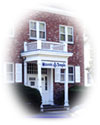 |
 |
|
Our next regular communication is |
|
|
FIDELITY LODGE
|
 |
|
SUPPORTS OUR TROOPS
|
HISTORY OF FIDELITY LODGE
Page 14
|
|
During the 25 year period following 1921, Fidelity's fortunes never waived. Neither the great depression nor the second World War materially retarded its growth or its financial stability. It experienced a concentrated increase in membership immediately after both World Wars. In 1921 fifty candidates were raised. In 1946 a single trestleboard listed 40 candidates awaiting reports and the various degrees.
In 1923 while W. Bro. William I. Bateman was Master, a member of Fidelity died leaving a son who was within a few months of completing his four year college course. The Master's investigation disclosed that, without assistance, this young man would be unable to complete his education. The situation was laid before the Lodge and money was raised. The boy stayed at school.
This incident inspired W. Bro. Bateman with the idea of establishing a permanent fund in Fidelity for student aid. He wrote to Grand Master who approved and sanctioned the plan. A resolution recommending that Fidelity establish an educational fund was voted. The committee of establishment was made up of W. Bro. Herbert Talbot, Chairman, and Brothers Percy Delamater, Bernard Forster, Robert Tennant and Edgar Wandless. The fund was first incorporated as "The Student Aid Fund of Fidelity Lodge." W. Bro. Bateman died in April 1926, and in commemoration of his sponsorship of the plan, the name was changed to "The Bateman Memorial Education Fund of Fidelity Lodge."
This fund has been ably administered by its officers and 27 sons and daughters of Masons in the Ridgewood area have substantially aided in completing their educations. The aid is made in the form of loans which the recipients repay after graduation as their circumstances permit. None of these loans has ever had to be written off as uncollectable.
During the years immediately following World War I, Fidelity Lodge grew so fast that attendance at its meetings often filled the lodge room to capacity. Other lodges over the state began to build new temples. Organizations, such as the YMCA, began erecting new buildings. Fidelity's trustees gave thoughtful and careful consideration to the problem of ultimately erecting a temple for Fidelity. Their conclusion was that the Lodge could not afford to go into debt for so great an amount of money as would be required to buy land, erect and maintain an adequate building for a temple. Their recommendation to the Lodge was that an investment of $7,500 be made for a plot of land located on the southeast corner of N. Maple Avenue and Linwood Avenue. The Lodge approved and on October 25, 1924, just eight months after 99 South Maple Avenue became free and clear, Fidelity took title to this lot. Meanwhile Lodge business slackened and this lessened the strain on the Lodge hall.
|
PAGES IN OUR HISTORY
|
|
|
||
|
HOME | CALENDAR
| DIRECTIONS | HISTORY
| LINKS | MASONIC EDUCATION
| MEMBERSHIP INFO | NEWS
| OFFICERS | PAY DUES
| SPECIAL EVENTS
|
||
|
©
- Fidelity Lodge #113 F&AM |